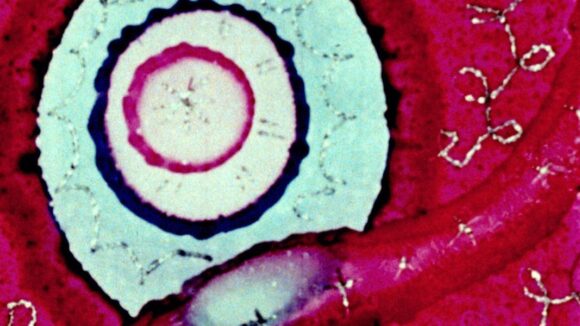

The Animation That Changed Me: Kim Keukeleire on ‘Begone Dull Care’
Kim Keukeleire joins us from Brussels for this week’s The Animation That Changed Me, a series in which leading filmmakers and artists discuss one work of animation that deeply influenced them. Keukeleire is one of Europe’s leading stop-motion animators, having worked on films like Chicken Run, Frankenweenie, My Life as a Zucchini, Fantastic Mr. Fox, and Isle of Dogs, and with companies including Passion Pictures, BBC Animations, Aardman, Cosgrove Hall, and Will Vinton Studios.
Her choice is Begone Dull Care, a 1949 short directed by the great experimental animators Norman McLaren and (uncredited) Evelyn Lambart at the National Film Board of Canada. The images were painted and engraved on film and scored to music by the Oscar Peterson Trio. Over to Keukeleire:

I first saw this film when I was a student in animation at La Cambre, Brussels. It must have been around 1988. It was a part of a retrospective about Norman McLaren at Annecy Festival. His whole work was a huge mind-opening, but this film had everything for me: experimentation, creativity, visuals, sound, movement, rhythm, tempo, dynamics, pace, energy. It is so rich. It might have been the originality, the diversity of the techniques, the creativity, his work with music and soundtracks that made an impact. I was marked by his work in general, not just one film. He made some films where he drew his own soundtracks — that was so cool for me too.
At that time, I had very little animation culture and the internet didn’t exist. Digital was not really accessible and everything was shot on film. Vfx and post-production were very expensive and not as big as now. Now, you can do anything in cgi, digital, or post-production without even shooting anything for real.
To see something so different and creative made me realize that there were no limits to what I can do in animation — anything could be animated. It was so exciting to see McLaren’s experimentations. Life and emotions coming from abstracts forms.
The symbiosis between the images and the soundtrack was just beautiful. I loved the way you can just watch without thinking about anything — just contemplate and follow with your eyes and ears to where it brings you. I realized how important music was to convey moods and emotions. I am more interested in moving emotions than moving objects.
Since then, music and soundtrack have always been very present in my character animation work. When I animate, I think in terms of how long this gesture will take, how many frames I’ll need from one position to another, how fast this will move, how fluid everything is, how synchronized different gestures are. I think about where I’ll have a pause, a silence, a breath, a succession of frenetic beats, high and low moments — like in music, like in life.
Unfortunately, I cannot draw, so to have other mediums to express myself was very liberating. When I was a student, I had the time and the space to experiment. I worked with many different mediums: cut-out, painting and scratching on film, object animation, chalk. And I always played with the soundtrack and music.

My dream was to be a musician and play drums, but unfortunately I am rubbish at music and have a very poor music culture. Perhaps I play my own music throughout my animation. All movements I make in animation are my own interpretation of life segmented in frames, in numbers of frames, in groups of frames.
If you look at people, they move in various ways. I can recognize the animators in their animations because they have their own style related to how they move. We all have our own rhythm, our own music, and that’s why we move and animate in different ways.
I like to compare animators with musicians. We play the same score, but through our personalities the interpretations end up different. The notes are the same, but played by different musicians, the music will be very different. I believe a director chooses the animators to work on a film for their specificities, like a conductor chooses their musicians for the way they interpret the music, for their style.

I also believe the animation is an alchemy between a director, the actors’ voices and delivery, the puppets, and the animators. Just like how there is an alchemy between a conductor, the instruments, and the musicians. That’s how some magic comes out!
I have not rewatched Begone Dull Care often. It was the impact it had on me when I first saw it that is important. At that time, I was young, eager to learn (I still am, luckily), and technology was very different. Now I think young students who watch this film might find it far too long and very old-fashioned.

